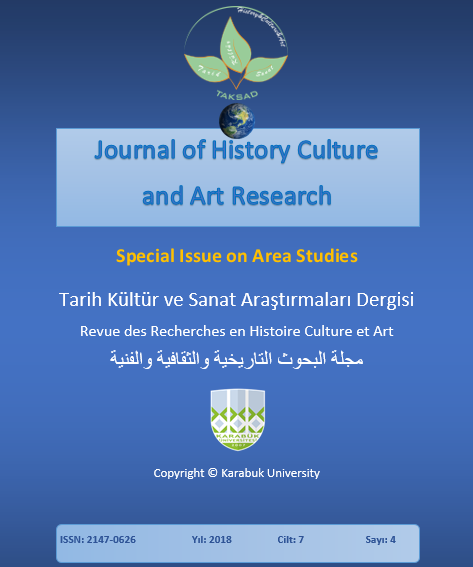The Meaning of Death for Adygs during the Years of the Caucasian War
DOI:
https://doi.org/10.7596/taksad.v7i4.1852Keywords:
the Caucasian war, Circassians, Heroics of death, Transformation of mentality, Female experiences, Caring for the death, Rhetoric of grief.Abstract
The article deals with issues of everyday life of Adygs (Circassians) under conditions of a protracted military conflict during the Caucasian war in the first half of 19th century. Based on the recollections of eyewitnesses and direct participants in the events (Russian military officers and foreign observers), literary works of local authors and folklore sources, authors of the study explore a human factor in the history of the Caucasian War, in terms of emotions, dramatic experiences, fears, and transformation of ethnic consciousness. In this regard, histories of everyday life, gender history, and history of mentality appear to be the most productive research methods and approaches. Using related research tools allowed analyzing an inner perception of death of Adygs in the violent conflict. Adygs appear in the study not as a faceless side of the conflict, but as an active and personalized historical subject.
The Caucasian war was not only a chain of political and war events, but was full of personal stories, tragedies of loss and sorrow, female experiences. The routine of death strengthened a respect for the dead, rebooting related symbolic content and ritual practices. At the same time, an erosion of the mental foundations of traditional culture occurs due to the fundamental changes in the conditions of prolonged war.
References
Broydo, G. I. (1936). Kabardian folklore. Society. Moscow: Academia.
Dubrovin, N. F. (1871-1888). The history of wars and domination of Russians in the Caucasus. Vol. 1-6. St. Petersburg: Printing house of the Department of Units.
Elmesov, A. M. (1991). From the history of the Russian-Caucasian War. ‘’Documents and Materials’’. Nalchik: Poligrafkombinat nameed after the Revolution of 1905.
Esadze, S. (1993). The Conquest of the Western Caucasus and the End of the Caucasian War. Maykop: Meoty.
Gippius, E. V. (1986). Folk songs and instrumental jokes of the Adygs. Vol. 3. Part 2. Moscow: Soviet composer.
Havzhoko Shawkat Mufti (1994). Heroes and emperors in Circassian history. Nalchik: El-fa.
Kazharov, V. H. (2005). Adygian songs of the Caucasian War period. Nalchik: Elfa.
Keshev, A. G. (1988). The notes of the Circassian. Nalchik: Elbrus.
Khan-Girey (1989). Circassian traditions. Nalchik: Elbrus.
Khan-Girey (1992). Notes on Circassia. Nalchik: El-fa.
Kumakhov, M. A. (2006). Adyghe (Circassian) encyclopedia. Moscow: The fund named after B.H. Akbashev.
Lapinsky, T. (1995). The highlanders of the Caucasus and their liberation struggle against the Russians. Nalchik: El-fa.
Longworth, J. A. (1974). A year among the Circassians. Adygs, Balkars and Karachais in the news of European authors of the XIII-XIX centuries. Nalchik: Elbrus.
Lorer, N. I. (1988). The notes of my time. Memoirs of the Decembrists. M.: Pravda.
Marzey, A. S. (2004). Circassian ridership, "ЗeкIуэ". Nalchik: Elfa.
Monpere, F. D. (1974). Journey through the Caucasus, to Circassians and Abkhazians, to Colchis, Georgia, Armenia and to the Crimea. Adygs, Balkars and Karachais in the news of European authors of the 13th-19th centuries. Nalchik: Elbrus.
Nalchikova, E. A. (2013). Heroic death as the commonness of masculine everyday life in the traditional Adygeyan society. In V.N. Skvortsova (eds.), Patriotism and citizenship in the daily life of Russian society (XVIII-XXI centuries). St. Petersburg.
Pirogov, N. I. (1952). Report on the journey through the Caucasus. M.: Medgiz.
Potto, V. (1994). The Caucasian War. Vol. 5. Stavropol: Caucasian Territory.
Potto, V. (1994). The Caucasian War. Vol. 2. Stavropol: The Caucasian edge.
Downloads
Published
How to Cite
Issue
Section
License
All papers licensed under Creative Commons 4.0 CC-BY.- Share — copy and redistribute the material in any medium or format
- Adapt — remix, transform, and build upon the material for any purpose, even commercially.
Under the following terms:
Attribution — You must give appropriate credit, provide a link to the license, and indicate if changes were made. You may do so in any reasonable manner, but not in any way that suggests the licensor endorses you or your use.
- No additional restrictions — You may not apply legal terms or technological measures that legally restrict others from doing anything the license permits.







